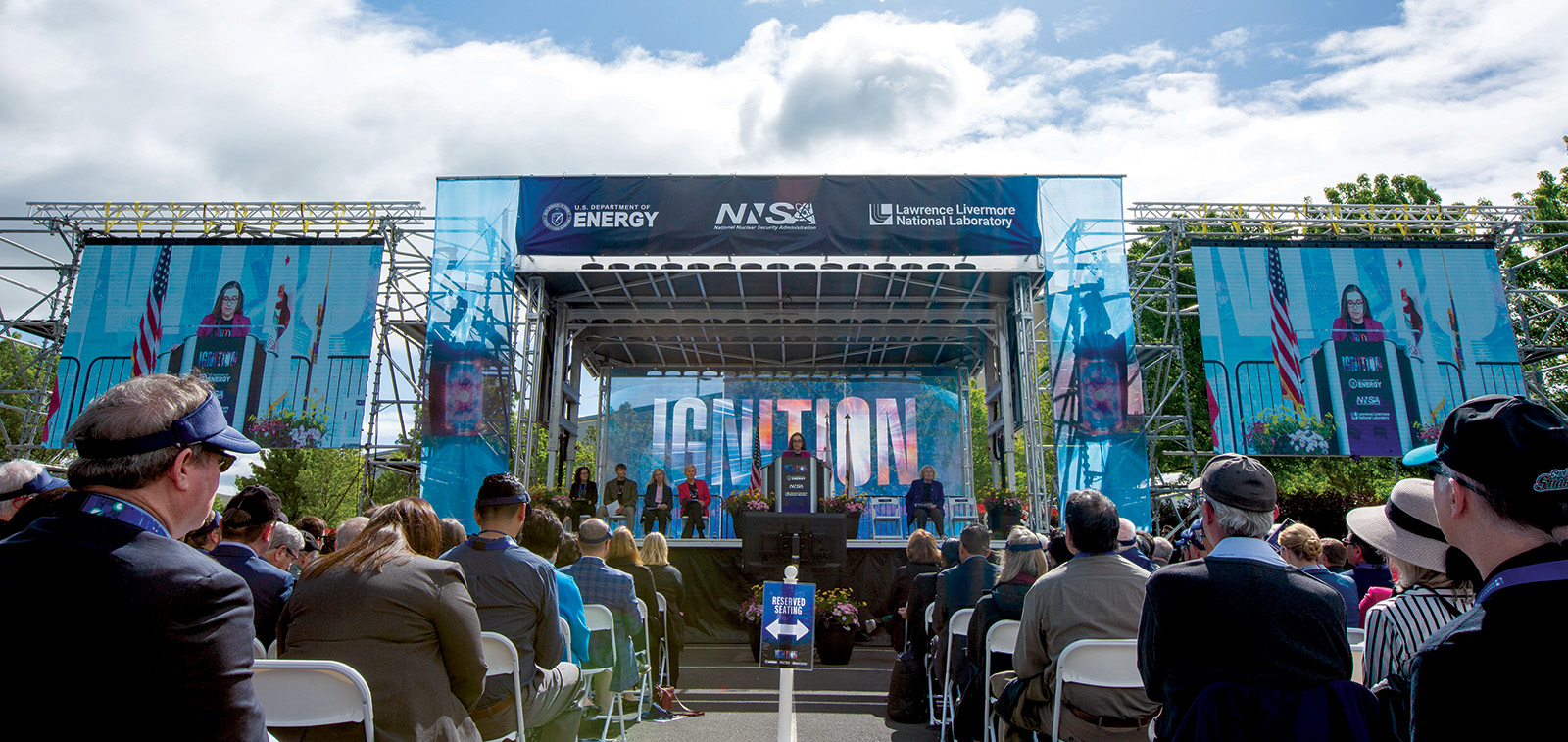Lawrence Livermore National Laboratory had another exceptional year pushing the frontiers of science and technology to strengthen national security in a rapidly changing world
FY 2023 was an extraordinary year for Lawrence Livermore National Laboratory (LLNL). The achievement of fusion ignition and energy gain in an experiment at the National Ignition Facility (NIF) on December 5, 2022, made headline news. The lead designer of the successful target, Annie Kritcher, even made TIME’s list of the year’s 100 most influential people. It was a deserved honor for her, and for the entire NIF team at LLNL, our many collaborators in the inertial confinement fusion research community, and those that took countless innovative steps over the past 60 years to make success possible. Ignition is a critically needed achievement as we work to modernize the nation’s nuclear weapons stockpile. It also dramatically demonstrates the value of the Department of Energy (DOE) national laboratories, where researchers pursue leading-edge, multidisciplinary science and technology (S&T) striving to reach impactful long-term goals in the national interest.
Scientists in the DOE National Nuclear Security Administration (NNSA) laboratories now have a breakthrough capability to directly study the complex physics of burning plasmas and test the properties of materials at extreme conditions. A better understanding of the underlying physics enables improvements to the simulation codes used to assess nuclear weapons performance. In addition, as mentioned in our Annual Report, NIF researchers have used the pursuit of ignition as a pioneering test bed for combining experimental data, high-performance computing simulations, and artificial intelligence/machine learning (AI/ML) to expedite scientific discovery and the engineering design of complex systems. With imminent first use of our newest supercomputer, El Capitan, we will have an order of magnitude more computing power and are on the verge of a transformational improvement in our ability to understand nuclear weapons physics and quantify performance uncertainties as we modernize the nation’s nuclear deterrent.
Transforming the Laboratory
Our Laboratory is undergoing a significant transformation. As a Federally Funded Research and Development Center (FFRDC), we need to change and aspire to serve as a model 21st-century national security laboratory. Greater agility is needed to anticipate and respond to growing threats to national security and international stability. We have important, technically and programmatically challenging mission responsibilities that require timely delivery within budget. And we see opportunities to make game-changing advances in national security through innovation and leading-edge S&T. Our transformation efforts align with NNSA’s 2022 Strategic Vision, which recognizes the need for the nation’s nuclear security enterprise (NSE) to step up to the daunting challenges our nation faces in a rapidly changing world. We need to “Innovate. Collaborate. Deliver.”
Transformation is most evident in our efforts to modernize weapons systems in the nation’s nuclear weapons stockpile—and in doing so, modernize the weapon-development process and production capabilities within the NSE. As our Annual Report describes, we are engaged in two programs to modernize stockpile systems: the W80-4 Life Extension Program, a warhead that will be carried on the all-new Long-Range Standoff missile, and the W87-1 Modification Program, a warhead for the Sentinel ballistic missile being developed by the U.S. Air Force. Through close partnerships with the NNSA laboratories, plants, and sites, we are developing new manufacturing technologies and business processes to improve efficiencies, lower costs, and increase NNSA’s agility. This is a team effort within the NNSA.
Building on Successes
A decade ago, LLNL launched initiatives to advance capabilities in manufacturing for national security applications. The investment has made a major impact. In support of our stockpile modernization programs, we are closely collaborating with NNSA production sites to bring efficient, cost-effective, and environmentally sound manufacturing processes into the NSE. They will be needed for production of both the W80-4 and the W87-1, which will be the first 100 percent newly manufactured nuclear weapon system for the nation in more than 30 years. DOE/NNSA multiyear investments in exascale supercomputing have brought El Capitan to LLNL, which greatly increases NNSA’s computing power and will provide important capabilities to certify a modernized nuclear weapons stockpile.
Another game-changing endeavor is underway with our leadership of the multi-institutional GUIDE program for the Department of Defense. We are building on our decades-long efforts in biosecurity and bioinformatics to achieve GUIDE’s goal of developing an AI/ML-enabled capability to design effective, safe and manufacturable medical countermeasures in days-to-weeks rather than years. Many other innovative research activities ranging from global security and climate change to fundamental scientific discovery are highlighted in our Annual Report.
Modernizing Facilities and Operations
LLNL is streamlining operations and providing leadership in moving forward NNSA’s Enhanced Mission Delivery Initiative (EMDI), which was undertaken to make the NSE more agile and reinvigorate the working relationship between NNSA and its FFRDCs. We are participating in many EMDI pilot projects. LLNL is already benefiting from earlier actions taken by NNSA to expedite construction and lower the cost of standardized (STAR) buildings. Activities are underway at the Laboratory for six new STAR buildings and two new facilities opened in FY 2023. Our 20-year Site Development Plan, updated in FY 2023, envisions a future campus designed to enhance productivity and employees’ work experience. The plan includes developing neighborhoods to increase opportunities for collaboration.
Attending to Workforce Development
Our successes in FY 2023 and bright prospects for the future are a credit to our outstanding workforce and the innovative ideas, energy, and commitment that our many new employees are bringing to LLNL. Nearly half of our employees have been at the Laboratory less than five years. We have established a cultural framework that focuses on addressing employees’ needs, continual learning and skill development, and career planning. It also strongly promotes IDEA—inclusion, diversity, equity, and accountability—as foundational to all we do.
Our workforce is key to successful transformation of our Laboratory. We are creating an environment that fosters innovative ideas and the ability to take on the grand challenges that LLNL missions demand. We are translating innovation into impactful solutions in the national interest. Science and Technology on a Mission, indeed.






